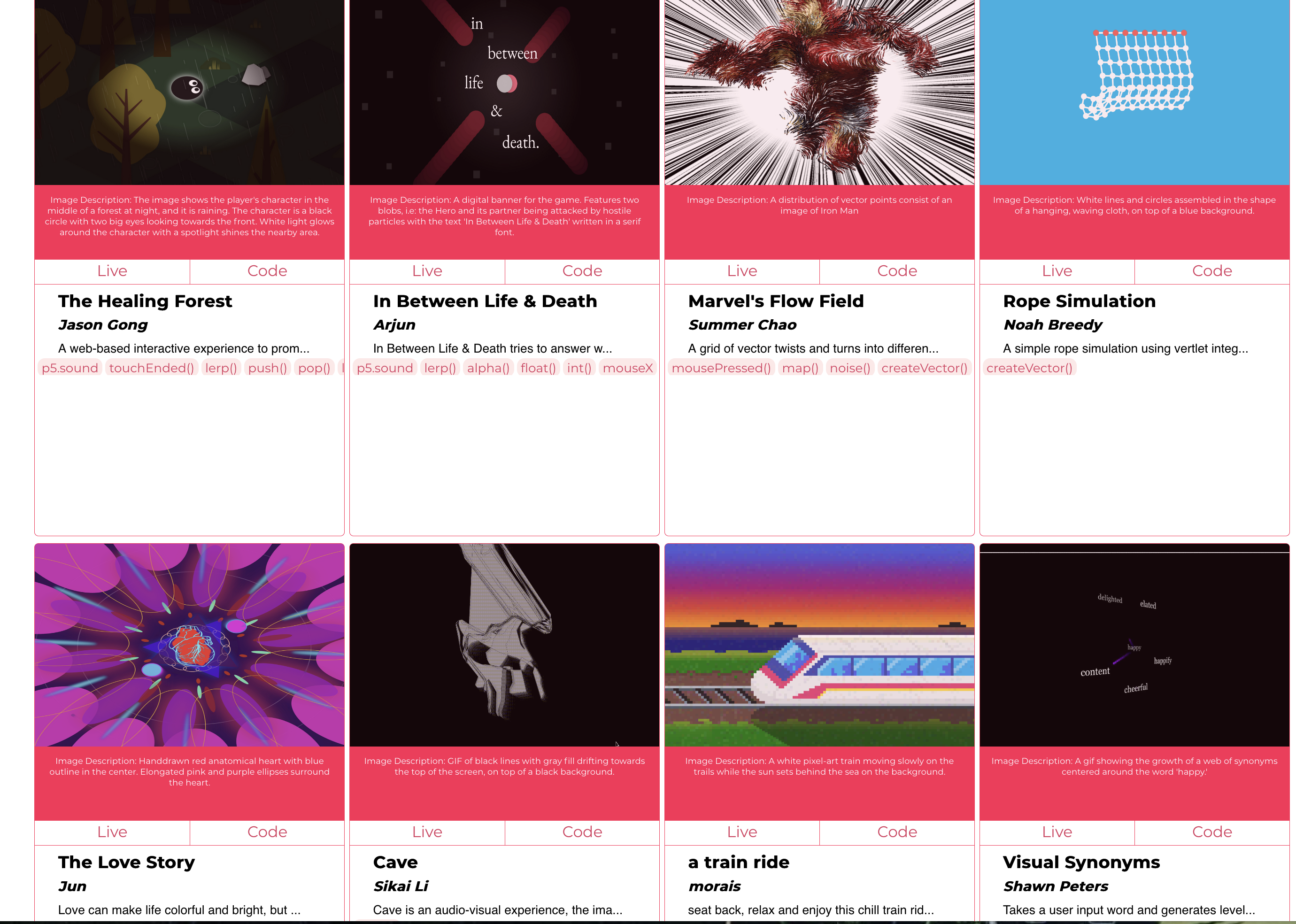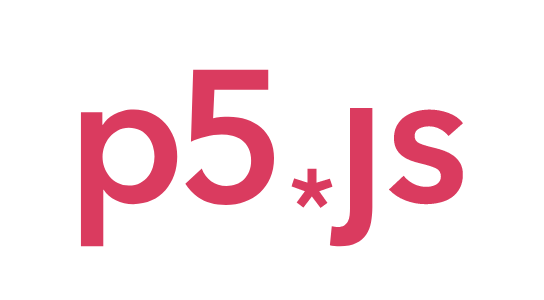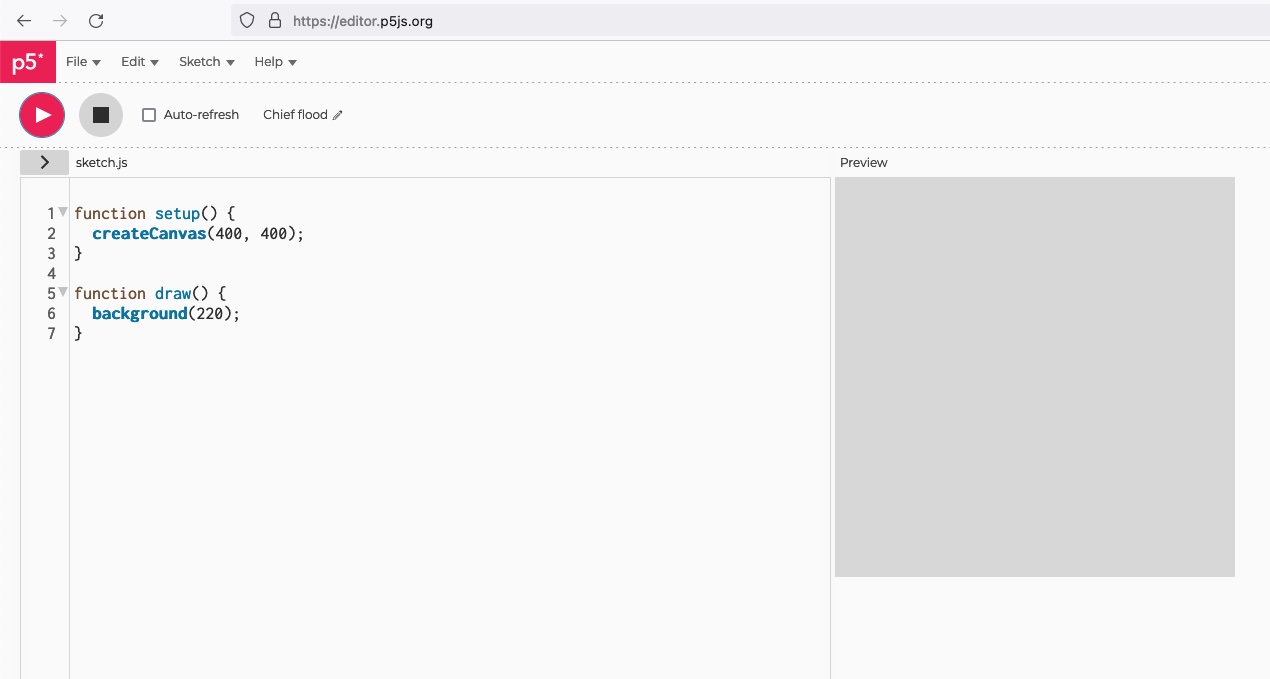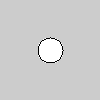1. Introduction
What's this course about?
Let's look at the title -- what's your perspective on these phrases?
- Digital arts
- Programming (using p5.js)
- Interactive
See the following examples from the p5.js Showcase:

The goal of this course is to teach you the fundamental techniques
underlying works like these, and give you the chance to develop your
own interactive works using the JAVASCRIPT with p5.js.
 To get there, we will cover topics such as how
to represent and manipulate two-dimensional shapes,
color, and images; how to represent and respond to
input from mouse, keyboard, webcam, and the network; and how to
represent and simulate the movements and
interactions of physical objects. See the
course
schedule.
To get there, we will cover topics such as how
to represent and manipulate two-dimensional shapes,
color, and images; how to represent and respond to
input from mouse, keyboard, webcam, and the network; and how to
represent and simulate the movements and
interactions of physical objects. See the
course
schedule.
Administrative stuff
See course homepage and canvas site.
- Who, what, where
- Philosophy
- Homework, quizzes
- Honor code
- Disabilities
Getting started
Walk through SA 1.
Get acquainted with the p5.js Editor, by playing with provided sketches; e.g., Visual | Data Visualization | Games | Advanced:
An example
The following steps build up an interactive sketch. Don't worry about the details here -- we'll do that over the next week(s). Just take it in holistically, to get a feel for what it's like to work with P5.Js. In general, a good way to learn is to copy examples into the p5.js editor yourself, and modify and play around with them, simply copy and paste from this page into the p5.js editor.
- We'll start with what's perhaps the simplest possible sketch -- an ellipse, here at position (50,50) and of size 25x25:
- That's not interactive, but by having the P5.Js draw() function plot an ellipse at the current mouse position each frame, we have perhaps the simplest possible interactive sketch, a drawing program:
- Now let's make it so that we only draw when the mouse is pressed:
- Let's customize the set-up and add in a splash of color to let our mouse draw "strings of soap bubbles":
// Initialization function setup() { createCanvas(500,500); // Make the window bigger smooth(); // Make the edges smoother (anti-aliased) background(0,0,0); // Black background strokeWeight(2); // Thicken the lines drawn } // What to do every frame function draw() { if (mouseIsPressed) { // Choose random red, green, and blue components of the fill and stroke color. // also make it a bit transparent fill(random(200,255),random(200,255),random(200,255),100); stroke(random(128,255),random(128,255),random(128,255),100); // pick a random radius and save it away var radius = random(50); // draw the ellipse ellipse(mouseX,mouseY,radius,radius); // draw a line connecting this position to the last one line(mouseX,mouseY,pmouseX,pmouseY); } }
- Let us makes our strings behave like a brush, where the color will fade away after a while.
To do this, we have to remember things (in this case when we clicked the mouse).
// let us remember the last time we clicked the mouse var strength = 0; // Initialization function setup() { createCanvas(500,500); // Make the window bigger smooth(); // Make the edges smoother (anti-aliased) background(0,0,0); // Black background strokeWeight(2); // Thicken the lines drawn } // What to do every frame function draw() { if (mouseIsPressed) { // set the strength to high strength = 1; // Choose random red, green, and blue components of the fill and stroke color // also make it a bit transparent fill(random(200,255),random(200,255),random(200,255),100); stroke(random(128,255),random(128,255),random(128,255),100); // pick a random radius and save it away var radius = random(50); // draw the ellipse ellipse(mouseX,mouseY,radius,radius); // draw a line connecting this position to the last one line(mouseX,mouseY,pmouseX,pmouseY); } else { // continue a fading stroke whe the mouse is released, until the strength fades completely if(strength > 0.05) { // Choose random red, green, and blue components of the fill and stroke color // also make it a bit transparent fill(random(200,255),random(200,255),random(200,255),100*strength); stroke(random(128,255),random(128,255),random(128,255),100*strength); // pick a random radius and save it away var radius = random(50); // draw the ellipse ellipse(mouseX,mouseY,radius,radius); // draw a line connecting this position to the last one line(mouseX,mouseY,pmouseX,pmouseY); // decrease the strength strength = strength * 0.95; } } }
- To make this a bit more interactive and give power to the computer to draw with us.
We will base the idea on an example by Sharp Hall
on the Processing exhibition.
The computer will either continue our strokes or start his own if we do not paint for a while. At random, he will also add some softer bubbles around.// Based on a sketch by Sharp Hall, http://stereotheism.org/071106/ // Stuff that needs to be remembered from one frame to the next var x, y; // The end of the line var dx, dy; // The length of the line var strength=0; // Computer-drawn lines decay and fade away var lastLineFrame=0; // When did the last computer-drawn line start? // Initialization function setup() { createCanvas(500,500); // Make the window bigger smooth(); // Make the edges smoother (anti-aliased) background(0,0,0); // Black background strokeWeight(2); // Thicken the lines drawn } // What to do every frame function draw() { if (mouseIsPressed) { // set the strength to high strength = 1; // Choose random red, green, and blue components of the fill and stroke color // also make it a bit transparent fill(random(200,255),random(200,255),random(200,255),100); stroke(random(128,255),random(128,255),random(128,255),100); // pick a random radius and save it away var radius = random(50); // draw the ellipse ellipse(mouseX,mouseY,radius,radius); // draw a line connecting this position to the last one line(mouseX,mouseY,pmouseX,pmouseY); // Remember this stroke x = mouseX; y = mouseY; dx = mouseX-pmouseX; dy = mouseY-pmouseY; lastLineFrame = frameCount; } else { if (frameCount - lastLineFrame > 150) { // Start a new random computer-drawn line x = random(width); y = random(height); dx = random(-20,20); dy = random(-20,20); strength = 1.0; lastLineFrame = frameCount; } if (strength > 0.05) { // Continue a decaying line kind of along the same direction var x2 = x, y2 = y; x = x+random(dx); y = y+random(dy); // Random color and weight like before; note that opacity is a function of strength fill(random(200,255),random(200,255),random(200,255),100*strength); stroke(random(128,255),random(128,255),random(128,255),100*strength); // pick a random radius and save it away var radius = random(50); // draw the ellipse ellipse(x,y,radius,radius); // draw a line connecting this position to the last one line(x,y,x2,y2); // decrease the strength strength = strength * 0.95; } } // Every 30-th frame, draw a random ellipse if (frameCount % 45 == 0) { // Choose darker random colors fill(random(30,100),random(30,100),random(30,100),100); stroke(random(30,120),random(30,120),random(30,120),100); // pick a random radius and save it away var radius = random(100,200); // draw the ellipse at random position ellipse(random(width),random(height),radius,radius); } }






